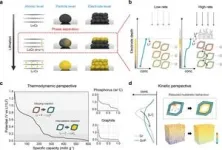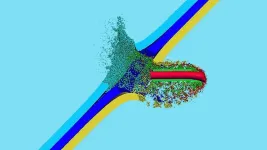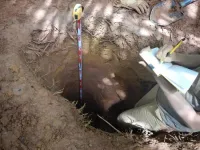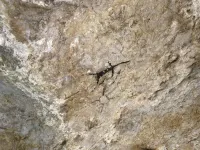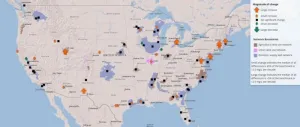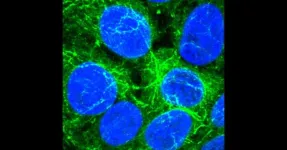(Press-News.org) In a major stride towards achieving fast-charging lithium-ion batteries (LIBs) with reliable cyclability, researchers at UNIST have made a groundbreaking discovery. Their study, published in the prestigious ACS Energy Letters, introduces a novel strategy of utilizing phosphorus nanolayers to enhance the lithiation kinetics and performance of graphite-based composites, without compromising safety.
Led by Professor Hyun-Wook Lee from the School of Energy and Chemical Engineering at UNIST, the research team developed a revolutionary graphite-phosphorus composite using a vaporization-condensation method. This composite consists of a porous graphite cathode material coated with red phosphorus and carbon, enabling improved electron and lithium ion conductivity on the graphite surface.
Achieving fast-charging LIBs with reliable cyclability remains a significant challenge, such as nonuniform lithiation, which can lead to performance degradation. However, the newly developed graphite-phosphorus composite electrodes exhibited a well-dispersed LiC6 phase volume fraction throughout the electrodes, indicating a homogenous lithiation process.
One of the remarkable achievements of this breakthrough is the consistent cycle retention of 94.4% and high Coulombic efficiency exceeding 99.8% over 1000 cycles at 1C. These exceptional results are attributed to the enhanced reaction kinetics of the graphite-phosphorus composite electrodes, despite their relatively high capacity.
“Graphite-based cathode materials are expected to dominate the lithium-ion battery market for the next decade,” explained Professor Lee. “Our research focuses on improving the energy density and fast-charging capabilities of graphite, which are key factors in the market.” He added, “The development of low-cost graphite cathode materials coated with red phosphorus and carbon will significantly meet the demands of the battery industry.”
The utilization of red phosphorus, with its low boiling point, allows for uniform vapor deposition on the graphite surface. By carefully controlling the deposition process, the research team successfully achieved a graphite-phosphorus composite with controlled side reactions, leading to enhanced uniformity and stability during fast charging.
Real-time optical microscopy and image processing techniques were employed to observe and analyze the developed composite. The results confirmed the uniform color distribution of the graphite-phosphorus composite during charging, indicating improved lithiation uniformity. The composite also demonstrated exceptional stability, with no resin phase formation observed during fast charging, even after 1,000 cycles or more.
This breakthrough research opens up new possibilities for a wide range of applications, including electric vehicles, aviation, and fast-charging batteries. The cost-effectiveness and superior performance of the graphite-phosphorus composite make it a promising solution to overcome the challenges associated with fast-charging LIBs.
This study was made possible with support through the 2023 Research Fund of UNIST and the Individual Basic Science & Engineering Research Program through the National Research Foundation of Korea (NRF), funded by the Ministry of Science and ICT (MSIT).
Journal Reference
Min-Ho Kim, Juyoung Kim, Seong-Hyeon Choi, et al., “Mitigating Electrode-Level Heterogeneity Using Phosphorus Nanolayers on Graphite for Fast-Charging Batteries,” ACS Energy Lett., (2023).
END
Mitigating electrode-level heterogeneity using phosphorus nanolayers on graphite for fast-charging batteries
2023-10-17
ELSE PRESS RELEASES FROM THIS DATE:
In 2020, 30% of the Pantanal was burned to cinders by wildfires
2023-10-17
In 2020, the Pantanal, the largest tropical freshwater wetland in the world and a biodiversity hotspot, was swept by high-intensity fires that destroyed native vegetation in an area totaling 44,998 square kilometers (km²), or about 30% of the Brazilian portion of the biome, which spans some 150,000 km². The estimate is presented in an article published in the science journal Fire.
The area destroyed by that year’s disastrous fires was far larger than had been thought, according to the article. ...
SwRI will advance impact modeling software for U.S. Army Corps of Engineers
2023-10-17
SAN ANTONIO — October 17, 2023 —Southwest Research Institute (SwRI) will continue advancing the Elastic Plastic Impact Computations (EPIC) dynamic finite-element code as part of an Other Transaction Prototype Agreement with the U.S Army Corps of Engineers. The first year’s funding of $500,000 has been awarded, with optional additional funding across the next three years totaling $3.5 million.
“EPIC uses finite element and particle methods to simulate complex impact and explosion scenarios,” said SwRI Staff Engineer Dr. Stephen Beissel, who leads the EPIC project and has been involved in EPIC’s development since the mid-1990s. ...
The earthworm effect: unraveling soil weathering dynamics
2023-10-17
17 October 2023
The Geological Society of America
Release No. 23-42
Contact: Justin Samuel
+1-303-357-1026
jsamuel@geosociety.org
For Immediate Release
Contributed by Sarah Derouin
Pittsburgh, Pa., USA: Earthworms, the hardworking invertebrates that grace the upper layers of soil, have long been considered helpful in our home gardens. Earthworms are prolific munchers, grinding up organic material and sediment grains that make up soils. Although they are very different animals, worms, like many poultry, have gizzards. “Worms will ingest some larger soil grains, and then they use the strongest and largest of those grains, retaining them in their gizzard,” ...
New dating of cave art reveals history of Puerto Rican people
2023-10-17
17 October 2023
The Geological Society of America
Release No. 23-40
Contact: Justin Samuel
+1-303-357-1026
jsamuel@geosociety.org
For Immediate Release
Leer en español.
Contributed by Sarah Derouin
Pittsburgh, Pa., USA: In the karstic caves of Puerto Rico, cave art paints the rock walls. Previous research has assigned ages to this art based on the ages of nearby archaeological artifacts within the caves, but these ages are relative and may not reflect the true timing of the art creation.
Now, a new study to be presented Wednesday at the Geological Society of America’s GSA Connects 2023 meeting shows that researchers have refined the age of this rupestrian ...
U.S. groundwater is getting saltier—what that means for infrastructure, ecosystems, and human health
2023-10-17
17 October 2023
The Geological Society of America
Release No. 23-41
Contact: Justin Samuel
+1-303-357-1026
jsamuel@geosociety.org
For Immediate Release
Contributed by Sarah Derouin
Pittsburgh, Pa., USA: Scientists from the U.S. Geological Survey (USGS) have been monitoring groundwater quality in wells across the country for more than three decades, looking for harmful chemicals or residual substances that may cause harm to ecosystems or humans. In all, they have measured up to 500 chemical constituents, including major ions, metals, pesticides, volatile organic compounds, fertilizers, and radionuclides.
Of ...
Pathogen that plagues food processing plants eradicated by blue light
2023-10-17
Washington, D.C. – Blue light kills both dried cells and biofilms of the pathogen Listeria monocytogenes, a frequent contaminant of food processing facilities. Demise of L. monocytogenes occurred quickest when cells or biofilms were placed on polystyrene, a widely used, transparent form of plastic. The research is published in Applied and Environmental Microbiology, a journal of the American Society for Microbiology.
“These results contribute to advancing our understanding of the potential of blue light to treat inert surfaces contaminated with L. monocytogenes,” said corresponding author ...
Public health interventions prevented transmission within BU most SARS-CoV-2 cases
2023-10-17
(Boston)— SARS-CoV-2, the causative agent of COVID-19, began impacting the U.S. in March 2020 with many schools and universities shifting to remote education by early April 2020 in response to the public health emergency. Despite public health interventions (increased ventilation, masking policies, surveillance testing, contact tracing of confirmed cases and quarantine procedures for infected students, faculty and staff) there were still concerns that institutes of higher education would be a hotbed of transmission, including transmission from students into surrounding communities.
But, were these fears warranted?
A ...
CastleVax Inc. receives BARDA project NextGen award valued at up to $338 million to advance intranasal NDV-based COVID-19 booster vaccine into phase 2b clinical efficacy testing
2023-10-17
CastleVax, a clinical stage vaccine platform company, has received a Project NexGen award valued at up to $338 million from the Biomedical Advanced Research and Development Authority (BARDA), part of the Administration for Strategic Preparedness and Response (ASPR) in the U.S. Department of Health and Human Services (HHS), to support the development of a next-generation, booster vaccine to protect against COVID-19 for years to come. The initial phase of the award provides approximately $8.5 million to plan a Phase 2b clinical trial that would compare CastleVax’s vaccine to currently ...
New cancer therapy target stops tumor cells from sharing resources
2023-10-17
Researchers at University of California San Diego have discovered a process in which liver cells share molecules via vesicle exchange in order to multiply under conditions that would ordinarily suppress cell proliferation. They also found evidence that this process occurs in various types of cancer cells, paving the way for a new approach to tackling treatment resistance in cancer. The findings were published on October 17, 2023 in eLife.
“Understanding cell proliferation is a fundamental issue in both cancer research and biomedical science as a whole,” said Gen-Sheng Feng, PhD, a professor of pathology at UC San Diego School of Medicine and of molecular biology ...
International team reveals source of largest ever Mars quake
2023-10-17
A global team of scientists have announced the results of an unprecedented collaboration to search for the source of the largest ever seismic event recorded on Mars. The study, led by the University of Oxford, rules out a meteorite impact, suggesting instead that the quake was the result of enormous tectonic forces within Mars’ crust.
The quake, which had a magnitude of 4.7 and caused vibrations to reverberate through the planet for at least six hours, was recorded by NASA’s InSight lander on May 4 2022. ...

